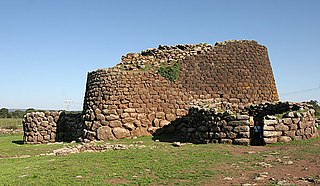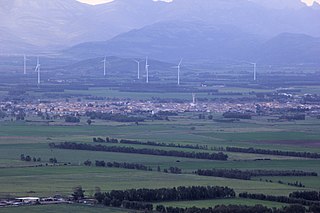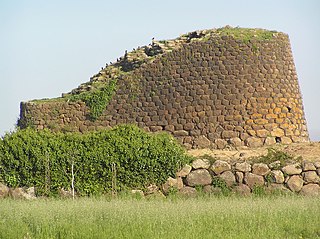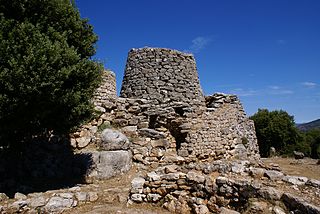
The nuraghe, or also nurhag in English, is the main type of ancient megalithic edifice found in Sardinia, developed during the Nuragic Age between 1900 and 730 B.C. Today it has come to be the symbol of Sardinia and its distinctive culture known as the Nuragic civilization. More than 7,000 nuraghes have been found, though archeologists believe that originally there were more than 10,000.

Su Nuraxi is a nuragic archaeological site in Barumini, Sardinia, Italy. Su Nuraxi simply means "The Nuraghe" in Campidanese, the southern variant of the Sardinian language.

Ittiri is a comune (municipality) in the Province of Sassari in the Italian region Sardinia, located about 160 kilometres (99 mi) northwest of Cagliari and about 15 kilometres (9 mi) south of Sassari. It is part of the Logudoro traditional region. Ittiri is located on a plateau at m. 450 on the sea level. The territory, made up of high plateaus mainly of trachytic and basaltic rocks, is rugged, hilly and crossed by valleys destined for cultivation; the most significant mountain ranges are: north-east on the line to Bessude Monte Torru, Mount Uppas and towards Banari Mount Jana ; south to Villanova mount Unturzu, mountain Alas, point S'Elighe Entosu and mountain Lacusa.

Pabillonis, Pabillonis in the Sardinian language, is a comune (municipality) in the Province of South Sardinia in the Italian region Sardinia, about 50 kilometres (31 mi) northwest of Cagliari and about 15 kilometres (9 mi) west of Sanluri.

Villanovafranca is a comune (municipality) in the Province of South Sardinia in the Italian region Sardinia, located about 50 kilometres (31 mi) north of Cagliari and about 13 kilometres (8 mi) northeast of Sanluri.

Sulcis is a subregion of Sardinia, Italy, in the Province of South Sardinia.

The nuraghe Losa is a complex prehistoric building in the shape of a tholos tomb. Its central structure has a triangular shape.

The Nuragic civilization, also known as the Nuragic culture, was a civilization or culture on Sardinia (Italy), the second largest island in the Mediterranean Sea, which lasted from the 18th century BC up to the Roman colonization in 238 BC. Others date the culture as lasting at least until the 2nd century AD and in some areas, namely the Barbagia, to the 6th century AD or possibly even to the 11th century AD.

The Giants of Mont'e Prama are ancient stone sculptures created by the Nuragic civilization of Sardinia, Italy. Fragmented into numerous pieces, they were discovered in March 1974 on farmland near Mont'e Prama, in the comune of Cabras, province of Oristano, in central-western Sardinia. The statues are carved in local sandstone and their height varies between 2 and 2.5 meters.

Santu Antine, also known as Sa domo de su re is a nuraghe in Torralba, one of the largest in Sardinia. It is located in the centre of the Cabu Abbas plain. The main structure was built around the 19-18th century BC, and the other parts of the nuraghe date back to the 17th–15th century BC. The main tower originally reached a height of 23–24 metres and contains three tholoi chambers on top of each other. The central tower with diameter of 15 metres is 17 metres high. Santu Antine is made of huge basalt blocks. It has three floors. The top floor is now gone. Some 27 meters long corridors built with the corbel arch technique can be observed inside of the Nuraghe, superimposed on two floors, the Nuraghe was provided with three wells.

The Nuraghe La Prisgiona is a nuragic archaeological site, located in the Capichera valley in the municipality of Arzachena Costa Smeralda in the north of Sardinia. It consists of a nuraghe and a village comprising around 90-100 buildings, spread across 5 hectares. Findings from this site are in many cases unique in Sardinia, particularly with regard to decoration and use. Due to the large extent and number of buildings the site is considered unique in North-East Sardinia. There is also some evidence for occupation during Roman and medieval times. The Giants' grave Coddu Vecchiu is located nearby.

The Nuraghe Arrubiu is one of the largest nuraghes in Sardinia. It is located in Orroli, in the province of South Sardinia. Its name means "red Nuraghe" in the Sardinian language, which derives from the basalt stones it had been built with.

The nuraghe Seruci is an important archaeological site, located in the municipality of Gonnesa, in the Iglesiente region of Sardinia.

The nuraghe Palmavera is an archaeological site located in the territory of Alghero, Sardinia. It is classified as a complex nuraghe, that consists of several towers joined together. The nuraghe and the surrounding village were built in various phase during the Bronze Age and the Iron Age.

The nuraghe Serbissi is a nuragic complex dating back to 18th-10th century BC. It is located in the municipality of Osini in Ogliastra, Italy.

The nuraghe Is Paras is an archeological site of Isili, a town in the historical region of Sarcidano, province of South Sardinia.

The Nuraghe Antigori is a nuragic complex dating back to the second millennium BC. It's located in the municipality of Sarroch, in the Metropolitan City of Cagliari.
The Casteddu de Fanaris is an important archaeological site located in the municipality of Decimoputzu, along the border with the town of Vallermosa, in the Province of South Sardinia.

Nuraghe Su Mulinu is an archaeological site located in the territory of Villanovafranca, in the province of South Sardinia.

The Nuraghe S'Urachi or S'Uraki is an archaeological site of the Bronze Age period located in the municipality of San Vero Milis, in the province of Oristano, Sardinia, Italy.





















